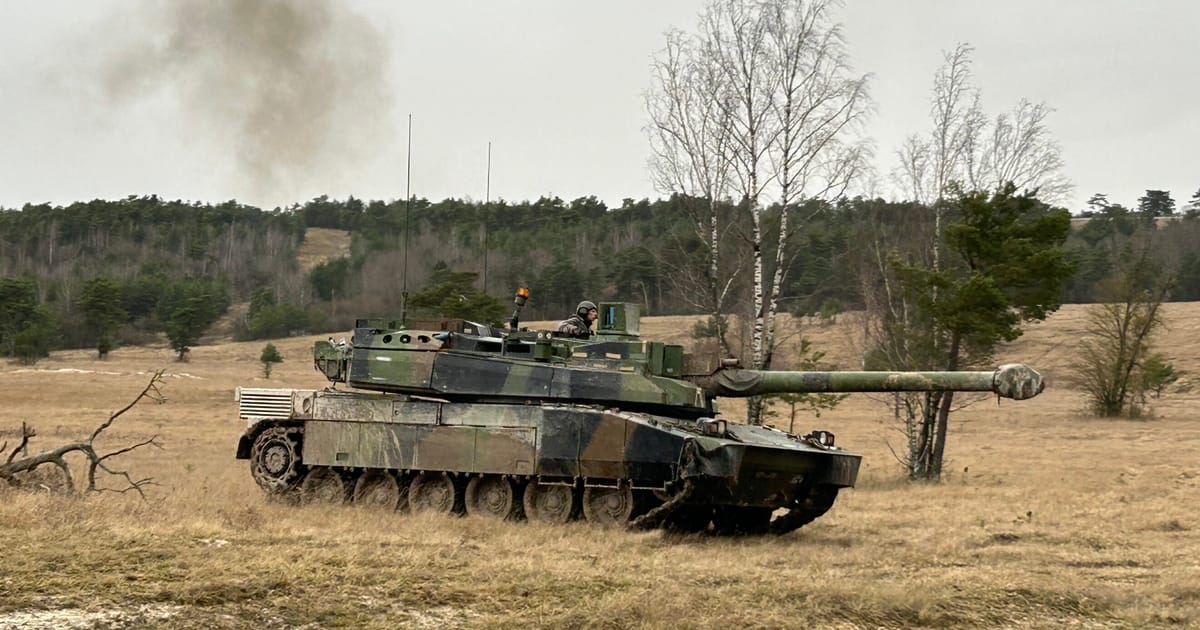A Leclerc tank during training at CENTAC | Laura Kayali for POLITICO | Laura Kayali
French troops are preparing for a high-intensity conflict against an enemy who can match them with firepower — a big change for an army that's spent the past decades fighting counterinsurgency campaigns in places like Mali and Afghanistan.
The hostilities in Ukraine, in their third year, have brought full-scale war back to the Continent, said Colonel Axel Denis, who runs the combat training center (CENTAC) at Mailly-le-camp in eastern France.
“The world has revealed its true nature: unstable, dangerous, and not everyone is a friend. We're gearing up for a culture of alert, of being ready at short notice,” he told POLITICO during a visit to the camp. "CENTAC is the only place [in France] where you can see what war is like."
Conditions for the troops training at CENTAC are as close as possible to an actual battlefield. The sound, heat and light of artillery fire is reproduced, while fake mines are scattered everywhere, and radio communications can be interrupted without notice.
The 120-square-kilometer camp is unique in France. With a surface area larger than Paris, it’s the only place where the French army's different units — infantry, armor, artillery and engineers — which are normally scattered all over the country, can exercise together. It's also the only place where two dozen Leclerc tanks are in action all year long.
The officers aren't naming potential enemies, but the training is aimed at preparing troops to fight a foe like Russia.
French troops learn to use maps and operate without electronic devices | Laura Kayali for POLITICO
After decades of military operations in Africa, France is increasingly focusing on Europe's eastern flank — and its armed forces need to be credible, army chief General Pierre Schill said in January. By 2027 the French army aims to be able to deploy one division of about 25,000 soldiers in 30 days.
"We're not in the same situation as Ukraine, but we're part of a coalition, and that comes with commitments," he said. "The notion of credibility in collective defense, particularly in NATO, is essential."
The CENTAC training camp in France has a surface bigger than Paris | Laura Kayali for POLITICO
Combined arms warfare
In the scenario designed for the French trainees, their goal is to slow down their enemies, played by seasoned troops permanently stationed at CENTAC. It's no easy task.The main lesson from Ukraine, CENTAC’s officers said, is to avoid frontal head-on assaults that result in huge casualty counts and fail to push the enemy back.
Instead, infantry, armor, engineers and artillery, integrated with new technology like drones that stream information back to the troops and provide killing power on the battlefield, must work together seamlessly.
“The war in Ukraine reinforced the importance of combined arms combat. It’s the only way to fight,” said Lieutenant Colonel Vincent, head of the camp’s coordination and steering office. His last name can’t be disclosed for security reasons.
Armies unable to combine tanks, artillery and infantry are at enormous risk — something demonstrated by both sides in Ukraine.
"What is dramatic in Ukraine is that you have tanks acting alone — and therefore no longer acting at all,” said Colonel Axel Denis.
The inability to coordinate is one reason why neither Ukraine nor Russia has been able to punch through the well-prepared defenses that now dominate over 1,000 kilometers of frontline.
"Russia’s armed forces are inadequately trained and resourced for combined arms” said the Association of the U.S. Army. That has forced Moscow to rely on wasteful human wave attacks rather than making speedy gains.
But neither has Ukraine mastered this approach, according to Guillaume Ancel, a former French military officer, leading to the current stalemate.
The Ukrainian soldiers undergoing training across the West are now learning such complex skills.
French soldiers undergo high-intensity warfare at CENTAC | Laura Kayali for POLITICO
'Hard training, easy war'
As the training gets underway, the mood is grim at CENTAC headquarters.
During a status update, officers announce that the enemy succeeded in destroying armored vehicles — leaving the trainees to fight the mission with less equipment.
The final exercise lasts 96 hours. Soldiers sleep an average of four hours a night, usually in uncomfortable military vehicles. They have to move every five minutes or face (fake) explosions.
“If their reaction is inappropriate, there's a penalty,” said Colonel Axel Denis. “It's a physical confrontation, but above all, it’s about a desire to last, to fight, to dominate.”
Trainees engage in electronic warfare, deal with the challenges of logistics and chemical threats, and have to make high-stakes decisions while sleep-deprived.
The soldiers also learn to work with maps instead of computers and phones — in what is called "downgraded mode"— to be prepared for situations on the battlefield where networks are jammed by their adversaries.
At a time when everyone is constantly hyperconnected, CENTAC trainers want troops to be aware of the risks on being online.
“Smartphones and social networks are a real threat for soldiers,” said Lieutenant Colonel Vincent. The enemy force has tools to detect signals and fires artillery at revealed locations; one captain lost his entire team because of a smartphone.
Once the training ends, the soldiers will get a performance assessment and a grade on a scale of one to five.
“We’ve never given a five,” said Lieutenant Colonel Vincent. As the French Foreign Legion's motto goes, "hard training, easy war," he added.

French soldiers train for the killing fields of Europe
“The world has revealed its true nature: unstable, dangerous, and not everyone is a friend,” said senior French colonel.

